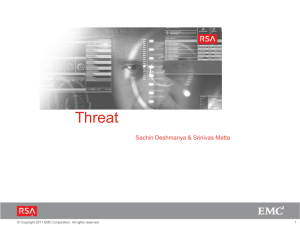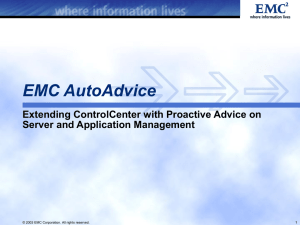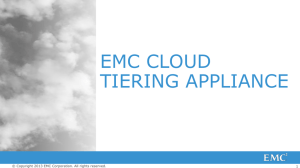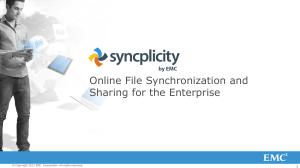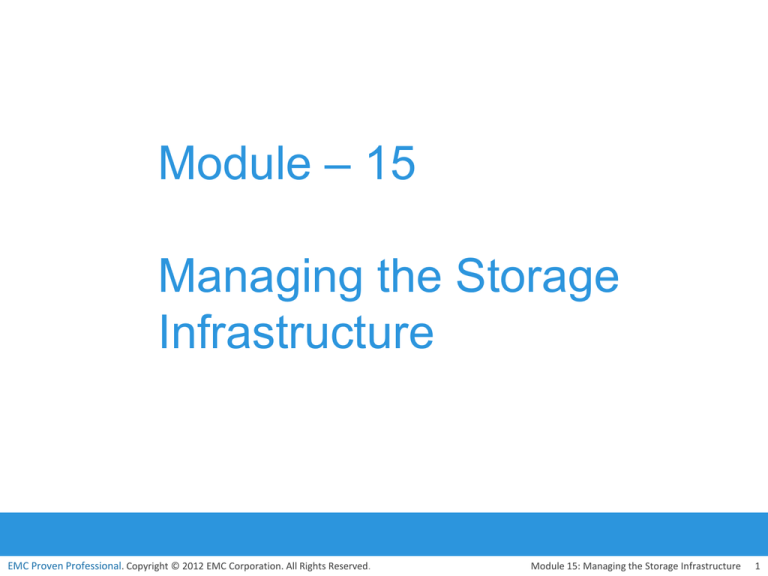
Module – 15
Managing the Storage
Infrastructure
EMC Proven Professional. Copyright © 2012 EMC Corporation. All Rights Reserved.
Module 15: Managing the Storage Infrastructure
1
Module 15: Managing the Storage
Infrastructure
Upon completion of this module, you should be able to:
• List the key storage infrastructure components that are
monitored
• List the key monitoring parameters
• Describe the storage management activities
• Describe the storage infrastructure management challenges
and their solutions
• Describe the information lifecycle management (ILM) strategy
EMC Proven Professional. Copyright © 2012 EMC Corporation. All Rights Reserved.
Module 15: Managing the Storage Infrastructure
2
Module 15: Managing the Storage
Infrastructure
Lesson 1: Monitoring the Storage Infrastructure
During this lesson the following topics are covered:
• Key storage infrastructure components that are monitored
• Monitoring parameters
• Types of alerts
EMC Proven Professional. Copyright © 2012 EMC Corporation. All Rights Reserved.
Module 15: Managing the Storage Infrastructure
3
Storage Infrastructure Management
• Managing storage infrastructure is key to ensure continuity of
business
Establishing management processes and implementing
appropriate tools are essential to meet service levels
Virtualization have changed the storage infrastructure
management paradigm
• Monitoring is the most important aspect that forms the basis for
storage management
EMC Proven Professional. Copyright © 2012 EMC Corporation. All Rights Reserved.
Module 15: Managing the Storage Infrastructure
4
Monitoring Storage Infrastructure
Clustered Server
Redundant Arrays
Client
Redundant HBAs
NIC
HBA
NIC
HBA
NIC
HBA
NIC
HBA
Redundant FC
Switches
IP
Redundant
Network
NIC Teaming
Production Storage
Arrays
Remote Storage
Arrays
Accessibility
• Key components that should be monitored are:
Servers
Networks
Storage arrays
EMC Proven Professional. Copyright © 2012 EMC Corporation. All Rights Reserved.
Capacity
Performance
Security
Parameters Monitored
Module 15: Managing the Storage Infrastructure
5
Monitoring Parameters
• Accessibility
To identify failure of any component that may lead to service
unavailability or degraded performance
• Capacity
To ensure availability of adequate amount of resources and
prevent service unavailability or degraded performance
• Performance
To evaluate efficiency and utilization of components and identify
bottlenecks
• Security
To ensure confidentiality, integrity, and availability of storage
infrastructure
EMC Proven Professional. Copyright © 2012 EMC Corporation. All Rights Reserved.
Module 15: Managing the Storage Infrastructure
6
Components Monitored – Host
• Accessibility
Hardware components such as HBAs, NICs, and internal disks
Status of various processes/applications
• Capacity
File system utilization
Database: table space/log space utilization
User quota
• Performance
CPU and memory utilization
Transaction response time
• Security
Authentication and authorization
Physical security (data center access)
EMC Proven Professional. Copyright © 2012 EMC Corporation. All Rights Reserved.
Module 15: Managing the Storage Infrastructure
7
Components Monitored – Network
• Accessibility
Physical components such as switches and ports
Logical components such as zones
• Capacity
Interswitch links and port utilization
• Performance
Assess individual component performance and help to identify network
bottlenecks
Monitoring port performance and link utilization
• Security
Unauthorized changes to the fabric
Login failures
EMC Proven Professional. Copyright © 2012 EMC Corporation. All Rights Reserved.
Module 15: Managing the Storage Infrastructure
8
Components Monitored – Storage
• Accessibility
Hardware components such as controllers and disks
Software processes such as replication processes
• Capacity
Capacity utilization and consumption trend
• Performance
Utilization rates of storage array components
I/O response time, cache utilization
• Security
Access control and physical security (data center access)
EMC Proven Professional. Copyright © 2012 EMC Corporation. All Rights Reserved.
Module 15: Managing the Storage Infrastructure
9
Accessibility Monitoring Example: Switch Failure
No redundancy due to
switch SW1 failure
H1
SW 1
Application
Servers
H2
SW 2
Storage Array
H3
→ Inaccessible
EMC Proven Professional. Copyright © 2012 EMC Corporation. All Rights Reserved.
Module 15: Managing the Storage Infrastructure 10
Capacity Monitoring Example: File System Space
FS Extended
Critical: FS is 80% Full
Warning: FS is 66% Full
Server
File System
Without File System Monitoring
Server
File System
With File System Monitoring
→ Inaccessible
EMC Proven Professional. Copyright © 2012 EMC Corporation. All Rights Reserved.
Module 15: Managing the Storage Infrastructure 11
Performance Monitoring Example: Array Port
Utilization
H1
SW 1
Port
Application
H2
Port
Servers
SW 2
H3
New Server
Port Utilization %
Storage Array
EMC Proven Professional. Copyright © 2012 EMC Corporation. All Rights Reserved.
100%
H1 + H2 + H3
Module 15: Managing the Storage Infrastructure 12
Security Monitoring Example: Storage Array
SW 1
WG2
Workgroup 2 (WG2)
WG1
SW 2
Storage Array
Warning: Attempted replication
of WG2 devices by WG1 user –
Access denied
→ Inaccessible
Workgroup 1 (WG1)
EMC Proven Professional. Copyright © 2012 EMC Corporation. All Rights Reserved.
Module 15: Managing the Storage Infrastructure 13
Alerts
• It is an integral part of monitoring
• It keeps administrators informed on the status of components
•
and processes
Monitoring tools enable administrators to assign different
severity levels for different events
Classified as information, warning, and fatal alerts
Type of alerts
Description
Information
• Provide useful information
• Creation of zone or
• Does not require administrator intervention
LUN
Warning
• Require administrative attention
• FS becoming full
• Soft media errors
Fatal
• Require immediate attention
• Component failure
• Power failure
EMC Proven Professional. Copyright © 2012 EMC Corporation. All Rights Reserved.
Example
Module 15: Managing the Storage Infrastructure 14
Module 15: Managing the Storage
Infrastructure
Lesson 2: Managing the Storage Infrastructure
During this lesson the following topics are covered:
• Storage infrastructure management activities
• Storage infrastructure management in virtualized
environment
• Storage infrastructure management challenges
• Ideal solution for storage infrastructure management
EMC Proven Professional. Copyright © 2012 EMC Corporation. All Rights Reserved.
Module 15: Managing the Storage Infrastructure 15
Storage Infrastructure Management Activities
Redundant Arrays
Client
Redundant HBAs
NIC
HBA
NIC
HBA
Redundant FC
Switches
IP
Redundant
Network
NIC Teaming
NIC
HBA
NIC
HBA
• Key components that should be managed are:
Servers
Networks
Storage arrays
Remote Storage
Arrays
Accessibility
Capacity
Performance
Security
Reporting
Clustered Server
Production Storage
Arrays
Management Activities
EMC Proven Professional. Copyright © 2012 EMC Corporation. All Rights Reserved.
Module 15: Managing the Storage Infrastructure 16
Availability Management
Availability Management
The goal of availability management is to ensure that the availability
requirements of all the components and services are constantly met.
• Key activity is to provision redundancy at all levels
• Example of availability management tasks are:
Installing two or more HBAs per server
Installing multipathing software
Deploying clustered server
Configuring RAID
Deploying redundant fabric
Configuring data backup and replication
EMC Proven Professional. Copyright © 2012 EMC Corporation. All Rights Reserved.
Module 15: Managing the Storage Infrastructure 17
Capacity Management
Capacity Management
The goal of capacity management is to ensure adequate availability of
resources, based on their service level requirements.
• Example of capacity management activities are:
Storage provisioning
Enforcing capacity quota for users
Capacity consumption trend analysis
• Technologies such as data deduplication, compression, and
virtual provisioning help to manage storage capacity efficiently
EMC Proven Professional. Copyright © 2012 EMC Corporation. All Rights Reserved.
Module 15: Managing the Storage Infrastructure 18
Performance Management
Performance Management
The goal of performance management is to ensure the optimal operational
efficiency of all components.
• Key activities are:
Fine tuning for performance enhancement
Identifying performance bottlenecks
• Example of performance management activities are:
Configuring multiple paths
Choosing appropriate RAID type and cache configuration
EMC Proven Professional. Copyright © 2012 EMC Corporation. All Rights Reserved.
Module 15: Managing the Storage Infrastructure 19
Security Management
Security Management
The goal of security management is to ensure confidentiality, integrity, and
availability of information.
• It prevents unauthorized access and configuration of storage
•
infrastructure components
Examples of security management tasks are:
Managing user accounts
Configuring zoning and LUN masking
Configuring encryption services
Installing antivirus and firewalls
Auditing of event logs
EMC Proven Professional. Copyright © 2012 EMC Corporation. All Rights Reserved.
Module 15: Managing the Storage Infrastructure 20
Reporting
• Involves gathering information from various components or
•
processes and generating reports
Commonly used reports are:
Capacity planning report
Configuration and asset management reports
Performance report
Chargeback report
EMC Proven Professional. Copyright © 2012 EMC Corporation. All Rights Reserved.
Module 15: Managing the Storage Infrastructure 21
Storage Infrastructure Management in Virtualized
Environment
• Virtualization technology has enabled managing storage
infrastructure efficiently
Virtualization at storage layer
Example: virtual provisioning of LUN
Virtualization at network layer
Example: VLAN and VSAN
Virtualization at compute layer
Example: Virtual machines, memory virtualization
EMC Proven Professional. Copyright © 2012 EMC Corporation. All Rights Reserved.
Module 15: Managing the Storage Infrastructure 22
Storage Multitenancy
• Enables multiple tenants to share the same storage resources
•
•
provided by a single landlord (resource provider)
Security and service level assurance are key concerns in a
multitenant storage environment
Secure storage multitenant environment should follow the four
pillars of multitenancy
Secure separation
Service assurance
Availability
Management
EMC Proven Professional. Copyright © 2012 EMC Corporation. All Rights Reserved.
Module 15: Managing the Storage Infrastructure 23
Storage Management Example 1 – Storage
Allocation to a New Server
Server
File/
Database
Management
File
System
Management
SAN
Storage Array
Allocate Volumes
to the Server
Volume
Management
Assign LUNs
to the Ports
Zoning
1
2
1
2
1
Database
Configured
File
Volume
System
Group
Configured Created
Create LUNs
Allocated
to the
Server
HBAs
Front-End
Ports
3
Assigned to
Storage Ports
3
Configured
Storage
Unconfigured
Storage
Storage Allocation Tasks
EMC Proven Professional. Copyright © 2012 EMC Corporation. All Rights Reserved.
Module 15: Managing the Storage Infrastructure 24
Storage Management Example 2 – Chargeback
Report
Engineering_1 Server
SW 1
Payroll_1 Server
Source
Vol 1
VG
LV
FS
VG
DB AppLV
FS
DB App
Remote
Replica
Vol 1
Source
Vol 2
C
A
Local
Replica
Vol 1
SW 2
Remote
Replica
Vol 2
Local
Replica
Vol 2
Unallocated
Unallocated
B
Application Servers
Production Storage Arrays
Remote Storage Arrays
Application
Storag
e (GB)
Production
Storage Raw
(GB)
Local Replica
Storage Raw
(GB)
Remote Replica
Storage Raw
(GB)
Total
Storage
RAW (GB)
Chargeback
Cost $5/Raw
(GB)
Payroll_1
100
200
100
125
425
2125
Engineering_
1
200
250
200
250
700
3500
EMC Proven Professional. Copyright © 2012 EMC Corporation. All Rights Reserved.
Module 15: Managing the Storage Infrastructure 25
Storage Infrastructure Management Challenges
Hitachi
EMC
Storage Arrays
CAS
HP
NAS
DAS
IBM
SAN
NetApp
TLU
SUN
Network
Servers
MF
UNIX
WIN
Databases
Oracle
Informix
Cisco
FC
Applications
IP
Brocade
MS SQL
EMC Proven Professional. Copyright © 2012 EMC Corporation. All Rights Reserved.
Module 15: Managing the Storage Infrastructure 26
Developing an Ideal Solution
One UI
Monitoring/Management Platform
Storage Arrays
CAS
NAS
Network
DAS
SAN
TLU
Servers, Databases, Applications
Network
Servers
MF
UNIX
WIN
Databases
Storage Arrays
FC
IP
Applications
EMC Proven Professional. Copyright © 2012 EMC Corporation. All Rights Reserved.
Module 15: Managing the Storage Infrastructure 27
Storage Management Initiative (SMI)
• SNIA has been engaged in an initiative to develop a common
•
storage management interface
SNIA developed a specification called Storage Management
Initiative-Specification (SMI-S)
It forms a normalized, abstracted model to which a storage
infrastructure components can be mapped
Enables standardized and end-to-end control of resources
SMI-S compliant products are easier and faster to deploy
Eliminates the need for development of vendor-proprietary
management interfaces
EMC Proven Professional. Copyright © 2012 EMC Corporation. All Rights Reserved.
Module 15: Managing the Storage Infrastructure 28
Enterprise Management Platform
• Suite of applications for managing and monitoring storage
infrastructure
Provides end-to-end management of physical and virtual resources
Generates alerts to inform the status of components and
processes
Schedules operations such as provisioning and configuration
management
EMC Proven Professional. Copyright © 2012 EMC Corporation. All Rights Reserved.
Module 15: Managing the Storage Infrastructure 29
Module 15: Managing the Storage
Infrastructure
Lesson 3: Information Lifecycle Management
During this lesson the following topics are covered:
• Challenges of managing information
• Information lifecycle management
• Storage tiering
EMC Proven Professional. Copyright © 2012 EMC Corporation. All Rights Reserved.
Module 15: Managing the Storage Infrastructure 30
Challenges in Managing Information
• Exploding digital universe
Multifold increase of information
• Increasing dependency on information
Strategic use of information plays an important role in determining
the success of a business
• Changing value of information
Information that is valuable today may become less important in
future
EMC Proven Professional. Copyright © 2012 EMC Corporation. All Rights Reserved.
Module 15: Managing the Storage Infrastructure 31
Value of
Information
Information Lifecycle Management
New
order
Process
order
Deliver
order
Warranty
claim
Time
Fulfilled
order
Create
Access
Aged
data
Migrate
Warranty
Voided
Archive
Dispose
A proactive strategy that enables an IT organization
to effectively manage the information throughout its lifecycle
EMC Proven Professional. Copyright © 2012 EMC Corporation. All Rights Reserved.
Module 15: Managing the Storage Infrastructure 32
Benefits of ILM
• Provides lower total cost of ownership
By aligning the infrastructure and management costs with
changing value of information
• Provides simplified management
By automating the processes
• Maintains compliance
Knowledge of what data needs to be protected for what length of
time
• Optimized utilization
By deploying storage tiering
EMC Proven Professional. Copyright © 2012 EMC Corporation. All Rights Reserved.
Module 15: Managing the Storage Infrastructure 33
Storage Tiering
Storage Tiering
It is a technique of establishing a hierarchy of storage types and identifying
the candidate data to relocate to the appropriate storage type to meet
service level requirements at a minimal cost.
• Each tier has different levels of protection, performance, and
cost
• Efficient storage tiering requires defining tiering policies
• Storage tiering implementations are:
Manual storage tiering
Automated storage tiering
• Data movement occurs between tiers
Within a storage array (Intra-array)
Between storage arrays (Inter-array)
EMC Proven Professional. Copyright © 2012 EMC Corporation. All Rights Reserved.
Module 15: Managing the Storage Infrastructure 34
Intra-array Storage Tiering
Tier 0
• LUN tiering
Moves entire LUN from
one tier to another
Does not give effective
cost and performance
benefits
LUN
Move entire LUN
with active data
from tier 1 to tier
0 for improved
performance
Tier 1
LUN
Move entire LUN
with inactive
data from
tier 0 to tier 1
LUN
LUN Tiering
• Sub-LUN tiering
Tier 0
A LUN is broken down into
smaller segments and
tiered at that level
Provides effective cost and
performance benefits
LUN
Move inactive
data from tier 0
to tier 1
Move active data
from tier 1 to tier 0
for improved
performance
Tier 1
Sub-LUN Tiering
Inactive Data
Active Data
EMC Proven Professional. Copyright © 2012 EMC Corporation. All Rights Reserved.
Module 15: Managing the Storage Infrastructure 35
Inter-array Storage Tiering
Facilitates policy-based
data movements
between tiers
Storage
Network
Policy Engine
Application Servers
Tier 1
Primary Storage
EMC Proven Professional. Copyright © 2012 EMC Corporation. All Rights Reserved.
Tier 2
Secondary Storage
Module 15: Managing the Storage Infrastructure 36
Cache Tiering
• Enables creation of a large capacity
•
•
secondary cache using SSDs
Enables tiering between DRAM
cache and SSDs (secondary cache)
Most reads are served directly from
high performance tiered cache
DRAM Cache
Tier 0
SSD
Tier 1
Tired Cache
Storage Array
Benefits
• Enhances performance during peak workload
• Non-disruptive and transparent to applications
EMC Proven Professional. Copyright © 2012 EMC Corporation. All Rights Reserved.
Module 15: Managing the Storage Infrastructure 37
Module 15: Managing the Storage Infrastructure
Concept in Practice
•
•
•
•
EMC ControlCenter
EMC Prosphere
EMC Unisphere
EMC Unified Infrastructure Management (UIM)
EMC Proven Professional. Copyright © 2012 EMC Corporation. All Rights Reserved.
Module 15: Managing the Storage Infrastructure 38
EMC ControlCenter
• An enterprise management platform
Contains storage resource management applications to manage a
multi-vendor storage infrastructure
• Provides an end-to-end view of the entire networked storage
•
•
infrastructure including virtualized environment
Enables implementation of ILM strategy by providing
management of tiered storage infrastructure
Has built-in security features that provide access control, data
confidentiality, data integrity, logging, and auditing
EMC Proven Professional. Copyright © 2012 EMC Corporation. All Rights Reserved.
Module 15: Managing the Storage Infrastructure 39
EMC Prosphere
• It is a storage resource management software, built to meet the
•
demands of the new cloud computing era
Following are the key capabilities:
Provides end-to-end visibility of all objects
Enables multi-site management from a single console
Improves productivity in virtualized environments with “Smart
Groups”
Enables fast, easy, and efficient deployment
Agent-less discovery of objects
Prosphere is packaged as virtual appliance
EMC Proven Professional. Copyright © 2012 EMC Corporation. All Rights Reserved.
Module 15: Managing the Storage Infrastructure 40
EMC Unisphere
• It is a unified storage management platform for managing:
EMC VNX and VNXe
EMC RecoverPoint/SE
• Some of the key capabilities offered by Unisphere are:
Provides unified management for file-based, block-based, and
object-based storage
Supports automated storage tiering
Provides management of both physical and virtual components
EMC Proven Professional. Copyright © 2012 EMC Corporation. All Rights Reserved.
Module 15: Managing the Storage Infrastructure 41
EMC Unified Infrastructure Manager (UIM)
• Unified management solution for Vblocks
• Enables configuring Vblock resources and activating services
• Provides a dashboard showing Vblock infrastructure
•
•
•
configuration and resource utilization
Provides a topology view of Vblock infrastructure
Provides an alerts console that lists alerts against adversely
affected resources and services
Performs compliance check during resource configuration
EMC Proven Professional. Copyright © 2012 EMC Corporation. All Rights Reserved.
Module 15: Managing the Storage Infrastructure 42
Module 15: Summary
Key points covered in this module:
• Key storage infrastructure components that are monitored
• Key monitoring parameters
• Storage management activities
• Storage infrastructure management challenges
• Enterprise management platform
• Information lifecycle management
• Storage tiering
EMC Proven Professional. Copyright © 2012 EMC Corporation. All Rights Reserved.
Module 15: Managing the Storage Infrastructure 43
Course Summary
Key points covered in this course:
• Key elements of data center environment
• Key components of intelligent storage systems and RAID
technology
• Storage networking technologies
• Business continuity solutions
• Cloud computing technology
• Security and management of storage infrastructure
EMC Proven Professional. Copyright © 2012 EMC Corporation. All Rights Reserved.
Module 15: Managing the Storage Infrastructure 44
Thank You!
EMC Proven Professional. Copyright © 2012 EMC Corporation. All Rights Reserved.
Module 15: Managing the Storage Infrastructure 45

